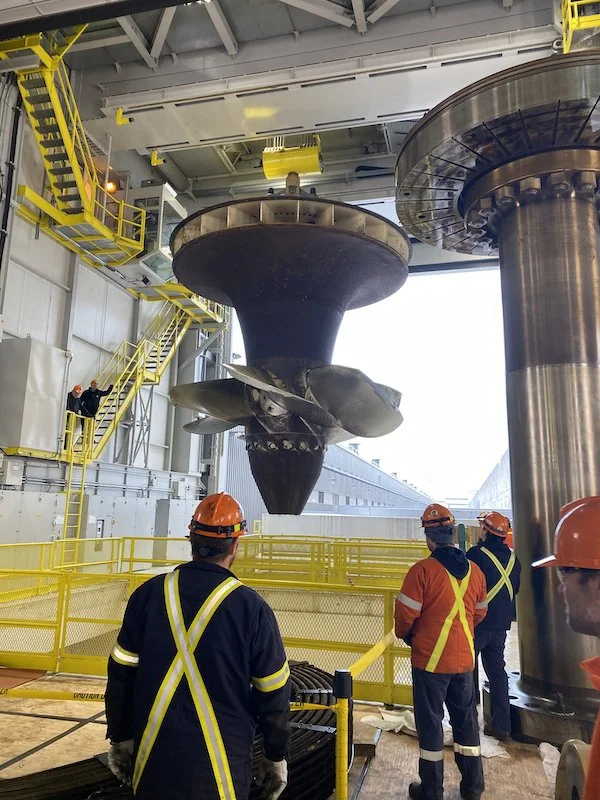Aging infrastructure, climate change and population growth are putting significant pressure on Montreal’s water resources. Faced with the magnitude of the issues and planned investments, the city is launching a public consultation on the future of water in its territory. Montreal is wasting too much drinking water, it is dumping too many pollutants into the St. Lawrence River, its aging infrastructure is unable to swallow the ever-increasing quantity of water spilled during torrential rains, and the city does not have enough money to update and adapt its infrastructure related to water management.
Montreal experiments with urban water features that could protect the St. Lawrence River
With both feet sinking into damp dirt, urban planner Pascale Rouillé surveys a narrow strip of land that will soon be used to not only retain runoff, but also be bursting with greenery that the community can enjoy. Tucked in next to a warehouse known as Bâtiment 7 in the Montreal neighbourhood of Pointe-Saint-Charles, near the intersection of Le Ber and Sainte-Madeleine streets, the terrain will become what has been dubbed a "blue-green alley."
Ottawa says it's making Canada's largest ever investment in protecting fresh water
The federal government says it's making Canada's largest investment ever in protecting the nation's sources of fresh water — including the Great Lakes. Commitments announced by the government during U.S. President Joe Biden's visit and in the recent budget bring the federal government's total investment to $750 million, said Environment Minister Steven Guilbeault.
River Institute, City of Cornwall and Watersheds Canada Receive Funding
The River Institute, in partnership with the City of Cornwall, and Watersheds Canada recently received funding to restore and naturalize two sites in Lamoureux Park, Rotary Creek and Rotary Point. Rotary Creek is a 257m stream that connects the historic Cornwall Canal to the St. Lawrence River. It is populated by a variety of species and provides spawning habitat for perch, bass, and chinook salmon. It is also home to the largest documented population of the cutlip minnow, a threatened species at risk in Ontario. In recent years, Rotary Creek has been impacted by invasive phragmites, which have spread and displaced native plants along the shoreline.
Major overhaul begins at OPG’s R.H. Saunders hydroelectric project
Ontario Power Generation (OPG) has launched a 16-year overhaul of the 1045MW R.H. Saunders Generating Station, the second-largest hydroelectric project in Ontario, Canada. The project began in January, with the first of the station’s 16 units, G9, now fully disassembled, with refurbishment set to be completed by early 2024. The overhauls of the rest of the station’s units will occur each subsequent year until the project wraps up by around 2039.
Clean water and a clean economy: DUC welcomes new investments in freshwater protection in 2023 federal budget
Today’s federal budget recognized that investing in clean water and climate action will deliver many benefits to the economy, to communities, as well as to the health and quality of life of Canadians. As the Government of Canada outlined its intentions to build a clean economy, one that aims to advance sustainable development while reducing environmental risks, new investments in freshwater protection and biodiversity will make important contributions to this goal. Budget 2023 announced new measures to support monitoring, assessment, and restoration of some of Canada’s most iconic – and threatened – lakes and rivers. Over 10 years, $650 million will help to assess and rejuvenate the Great Lakes, Lake Winnipeg, Lake of the Woods, St. Lawrence River, Fraser River, Saint John River, Mackenzie River, and Lake Simcoe.
The Archipelago reeve joins Summit on Fresh Water in Ottawa
Reeve Bert Liverance of the Township of The Archipelago joined a delegation of local government leaders who are members of the Great Lakes and St. Lawrence Cities Initiative (Cities Initiative) at the Summit on Fresh Water in Ottawa, hosted by the Canada-United States Inter-Parliamentary Group. The summit brought together diverse voices to highlight the importance of the Great Lakes and St. Lawrence River to Canada’s economy and quality of life. The Cities Initiative played an active role in preparations for the event.
How expanding Montreal's wastewater treatment plant will help the environment
The city of Montreal is looking to significantly reduce its own greenhouse gas emissions while vastly improving the St. Lawrence River's water quality by overhauling its wastewater treatment plant. As part of Montreal's 2023 budget (presented in November) the city earmarked $682 million over 10 years to replace the incinerators at the Jean-R.-Marcotte plant in Rivière-des-Prairies–Pointe-aux-Trembles.
What one region's water level woes reveal about climate change and the St. Lawrence River
Strolling along the shore of his home on Ault Island, about 30 minutes west of Cornwall, Ont., Cliff Steinburg points to the end of his dock. He says this summer there was less than a foot of water there, making it impossible to launch a boat. While the river has since stabilized, Steinburg worries what next year will bring to a region known for its fishing, beaches, and boating. "This area cannot go through another season like we did," Steinburg said. "It's going to have a major effect on tourism. It's going to have a major effect on all of us living here."
Lower water levels affecting Canadian crop shipments
Although the lower river levels of the Mississippi River are perhaps better documented as affecting the movement of product into and through the US, Canada’s St. Lawrence River is also experiencing its shortcomings. The St. Lawrence River route with ports on both the US and Canadian sides moves a lot of agricultural products—about 40 percent of the Seaway’s trade. Note that the St. Lawrence route also moves cargo down via the Mississippi into the US, and vice versa.
Algae to blame for 'earthy' taste of drinking water, Pointe-Claire says
The city of Pointe-Claire issued a statement to local residents Wednesday, saying the “earthy” taste and unusual odour emitted by their tap water is due to the increased presence of algae in the St. Lawrence River and does not represent a danger to the public’s health. Noting that “a slightly different odour and taste might be noticed in the drinking water coming from the city of Montreal’s Pointe-Claire water production plant,” the municipality explained that such situations occur “during summer and fall and are due to algae in the river.”
Lake Ontario outflows downstream now fourth highest on record
Joint Canada-U.S. regulators of Lake Ontario water levels say they are monitoring ice-cover conditions to ensure proper outflows from the Moses Saunders Dam into the St. Lawrence River. Outflows from Lake Ontario are higher than usual for this time of the year, said regulators. International Lake Ontario – St. Lawrence River Board said, “although flows have been reduced, the outflows remain relatively high compared to the historical record. The average Lake Ontario outflow for January 2022 is currently the fourth highest on record since 1900 (following 2020, 2021, and 1987), and the January mean Lake Ontario level is the 15th highest on record since 1918.”
Cornwall Council hears of serious vulnerability to city’s water supply
Cornwall City Council received a report from EVB Engineering at a special meeting on Monday, Nov. 1 about a potential vulnerability to the city’s water supply and solutions on how to address the problem. The water received at the City of Cornwall’s Water Purification Plant (WPP), located on Second St. W., is taken from the St. Lawrence River through an intake pipe located west of the R.H. Saunders Dam in the city’s west end. That pipe is roughly 65-years-old and is reaching the end of its service life. Even if it were not so old, the fact that the water plant has only one intake pipe was identified as a vulnerability in the system.
Review of Plan 2014 continuing
Plan 2014, which the International Joint Commission (IJC) uses to manage water levels and flows in Lake Ontario and the St. Lawrence River is currently under review, however, any major changes to the plan are still a long way off. Criticism of the plan prompted an expedited review which began in early 2020. Wendy Leger of the Great Lakes-St. Lawrence River Adaptive Management (GLAM) Committee, which is carrying out the review, says the first phase of the review is scheduled to be completed by the end of October. Leger made the comments in a recent IJC webinar.
IJC: Water levels have likely peaked for the year
The International Joint Commission (IJC) held a public meeting on Tuesday, June 15 to discuss water levels in Lake Ontario and St. Lawrence River. The IJC is a bi-national governing body comprised of representatives of Canada and the United States (US) which manages the water levels of Lake Ontario, and the St. Lawrence River. IJC U.S. Secretary Bryce Carmichael told the audience of the virtual meeting that the organization was dealing with drought conditions throughout the region this season.
A TALE OF THREE WATERSHEDS: WHAT WE KNOW — AND DON’T KNOW — ABOUT THE HEALTH OF CANADA’S FRESHWATER
Canada is famously home to 20 percent of the world’s freshwater — but how well are we stewarding this supply? WWF-Canada recently reassessed the health of our country’s 25 watersheds to better understand how they’re responding to threats from pollution, habitat loss and climate change. Our 2020 Watershed Reports found that 26 per cent of Canadas’s 167 sub-watersheds received a score of Good or Very Good, which is good or very good news! But what’s bad, or possibly very bad, is that nearly 60 per cent of these sub-watersheds received no score at all because they remain Data Deficient. In other words, we just don’t know. This lack of data is concerning as we need a complete picture to determine which areas need dedicated efforts to protect our freshwater ecosystems.
400 billion gallons of raw sewage was dumped into Canadian water
Canadian municipalities are dumping an estimated 400 billion gallons of raw sewage every year. Quebec is the worst offender—leading all other provinces in their failure to meet federal water safety regulations, according to documents obtained through an access to information request by news outlet Blacklock’s Reporter. The Department of the Environment stated that of the 3.4 billion cubic metres flushed per year across Canada, 374 billion gallons went untreated and did not meet the limits. The department’s researchers also predict the actual discharges are likely much higher.
Cities urge federal leaders to wade into wastewater debate
In Canada's largest city, raw sewage flows into Lake Ontario so often, Toronto tells people they should never swim off the city's beaches for least two days after it rains. Across the country in Mission, B.C., a three-decade-old pipe that carries sewage under the Fraser River to a treatment plant in Abbotsford is so loaded operators can't even slip a camera inside it to look for damage. If that pipe bursts, it will dump 11 million litres of putrid water from area homes and businesses into a critical salmon habitat every day it isn't fixed.
Protesters take to the water against Chalk River nuclear disposal site
People from both sides of the Ottawa River took to the water to protest the construction of a nuclear waste disposal site at the Chalk River power plant. More than a dozen boats took part in the demonstration to say the federal government should heed their warnings about the potential dangers the dump presents for the health of the water.
Laced with fear: why some Ontario First Nations don't trust tap water or eat the fish
Water is something most Canadians take for granted. We have so much of it, it's no wonder. Per capita, our country has the world's third-largest freshwater reserves, but yet in many Indigenous communities, water can be difficult to access, at-risk because of unreliable treatment systems, or contaminated. That's the case in Delaware First Nation, an Indigenous community of about 500 people an hour southwest of London, Ont., a place where fishing was everything 60 years ago.





















